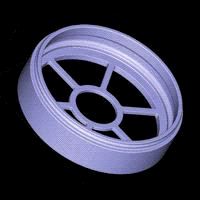Inkjet & Digital Printing
BREATHING EASIER ON THE TRACK

Thursday 27. March 2014 - FDM Carbon Monoxide Filter Takes the Heat
When it comes to safety, the Joe Gibbs Racing (JGR) design engineers don’t leave anything to chance. Thanks to a new SR-100 soluble support material used with Fused Deposition Modeling (FDM) from Stratasys, they can now create complex carbon monoxide filter housings for their cars using polycarbonate (PC) material, which has a higher temperature rating than the previous material used.
“We are now very comfortable producing quality production parts using our Fortus system,” said Brian Levy, JGR design engineer. “We don’t worry about them melting or failing during a race.”
Joe Gibbs Racing is a premier NASCAR organization with three sponsored cars. Its engineers design and develop parts to enhance the performance of these cars, while maintaining the highest possible safety standards for the drivers. Using FDM to accelerate product development, they create concept models, functional prototypes, manufacturing tools and even end-use parts right in their North Carolina facility. The filter housing is the newest part.
A Safer Car
Each JGR vehicle contains a filter mounted in line with the driver’s air conditioning unit that helps clean the air blown into the driver’s helmet. “The filter reduces carbon monoxide levels to make the environment safer for our drivers,” said Levy. The housing sits close to the car’s floor and exhaust system, where it’s exposed to temperatures as high as 200 F.
The filter itself is housed in a two-piece assembly that snaps together permanently, making it single-use. “We designed it this way so we don’t have to worry about reliability,” said Levy. “Any other fastening method would make us less confident in our design.” In addition to high temperatures, the housings must withstand the vibration of a speeding race car.
Design Freedom
Because the SR-100 support material washes away from the part after it has been built, design engineers have the freedom to make the part as complex as they want. In the past, JGR was hesitant to produce the part with FDM because, while PC offered strength and heat resistance, no soluble support material was available for use with PC. Supports were broken away by hand, making it difficult to clean cavities, especially on parts with complex geometries, like the filter housing.
“The complex design of the part makes it ideal for an FDM application,” said Levy. “To design these parts to work the way we want them to, we need complex geometry. If we tried to machine the part, we would be forced to sacrifice some of its performance to satisfy machining constraints.”
In addition, Levy and his colleagues want to take some of the load off the CNC department. “Anything we can do to take work off of their plate and find other manufacturing processes is a big help,” Levy said. “This is one of our higher-quantity parts. We produce over 200 a year for all of the race teams. That would be a large order for our CNC department.”
